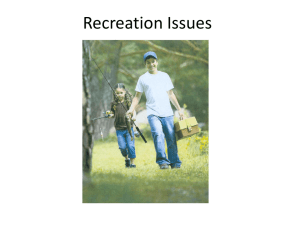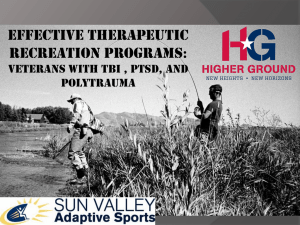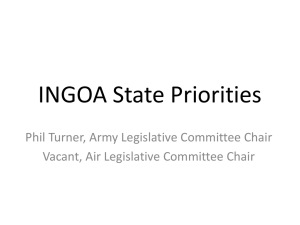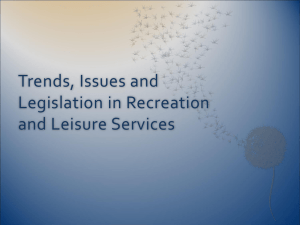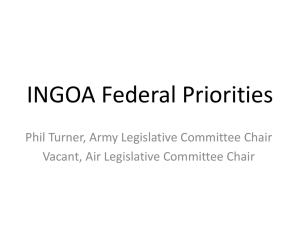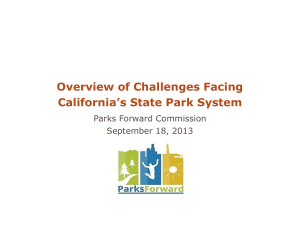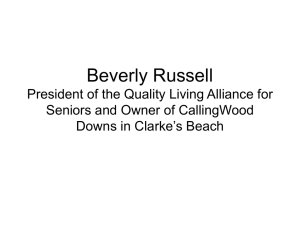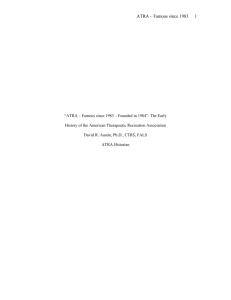File
advertisement
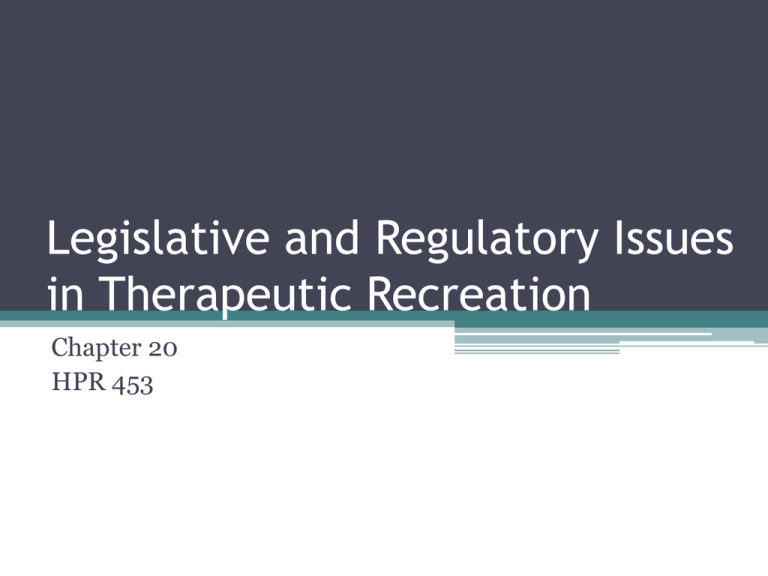
Legislative and Regulatory Issues in Therapeutic Recreation Chapter 20 HPR 453 • Houle (1980) included legal support as a distinct characteristic of a profession • Skalko (1998) contends that the TR profession must work to influence public policy and healthcare regulation • Compton (1997) stated that if TR was to survive it must become more politically astute 40 Year History • 1966 – Creation of NRPA and NTRS • Early legislative effort reflected society’s to advance the condition of all persons • 1970 – Legislative advocacy declared to be a priority for NTRS • 1973 – Rehabilitation Act of 1973 – considered to be the “civil rights law for disabled persons” – contained references to recreation being an integral part of comprehensive rehabilitation • 1975 – Sen Ted Kennedy Education for all Handicapped Children Act strongly supported by recreation and Phys Ed professionals • NTRS’ legislative efforts managed by a legislative committee and volunteer support • 1984 – ATRA formed and public policy coordinated by Team appointed by the Pres • 1993 – ATRA hires legislative counsel in DC • TR continues to depend heavily on Grassroots support • Consistent targets for TR legislative action have been ▫ Rehabilitation, ▫ Education ▫ Nursing Home Reform Rehabilitation • Used to be viewed as vocational preparation and training • Rehabilitation Act of 1973 introduced “comprehensive rehabilitation” ▫ Fullest possible participation in life, including living independently in the community ▫ Congress then more receptive to considering the role of recreation in rehabilitation and independent living • NTRS testimony influenced the US Senate to amend the law in 1978 to include “special recreation demonstration projects” ▫ Intended to increase mobility and socialization of disabled persons through activities such as camping, sports and the arts • Amended again due to personal testimony ▫ Extended and expanded the role of recreation in independent living and community integration ▫ TR personnel recognized as bonafide rehab personnel eligible for rehab training monies ▫ Congress recognized TR as a means to reach desirable goals in the overall rehab process Education • 1975 - Education for All Handicapped Children Act ▫ Mandated a free and appropriate education for all children with disabilities in a least restricted environment ▫ Crafted so recreation would appear as a content area “related” to special education ▫ If a child’s eval indicated a need their IEP would include assessment of leisure functioning, TR, Leisure Ed, or rec programs in the school or the community • Recreation was rarely found to be included in the IEP but recommended for after school programs • In 1991 the law was retitled to Individuals with Disabilities Education Act (IDEA) with the intent of TR transitioning a child from school into adult life (full inclusion) • TR still not fully utilized in schools but progress is being made Long-Term Care • OBRA regulations weakened nursing home requirements for activities and the staff who provided them • TR lobbying efforts eventually earned TR important recognition and respect • MDS 2.0 (1998) contained Section T to distinguish Recreation Therapy from Activity (diversional) services • MDS 3.0 – RT in Section along with other rehab svcs Accessibility • Americans with Disabilities Act (1990) is one of the most significant pieces of legislation to impact access to recreation activities for people with disabilities • No specific provisions for TR but prohibits disability discrimination in employment, govt services, public accommodations, telecommunications, and certain other services, like insurance Legislative Process • 3 fundamental processes related to introducing, passing and implementing law ▫ Authorization ▫ Appropriation ▫ Regulation Authorization • Law under which a program is established or continued (reauthorization) for a stated number of years (perhaps 5) • Specifies the aim and conduct and ceiling on the monies • Extensive lobbying by TR when laws such as Rehabilitation Act or IDEA have been up for reauthorization • Oral and written comments to change statuatory language (success and lack of on pg 330) Appropriation • Means by which authorized programs are funded by Congress for that year • Funding may not include funding amounts in Authorization • Originates in House and followed by one in the Senate • When different compromised and taken back to the House • TR lobbying for special recreation funding has been successful due to providing for people with disabilities Regulation • Organization, rules and procedures to distribute funds and monitor conduct of programs • Proposed regulatory changes are announced in Federal Register and public is invited to comment • In 1991 NIDRR was successful in securing funding for research projects such as Benefits of Therapeutic Recreation: A Consensus View ATRA Medicare Project • Regulatory language implies that RT is a covered service in skilled nursing, IP Rehab and IP Psych facilities • Beneficiaries often denied services due to inaccurate interpretations of fiscal intermediaries • H.R. 4248 Ensuring Medicare Access to Recreational Therapy Act of 2007 • Bottom line - Requires resources ($) and coordinated Grassroots efforts Essentials for Legislative and Regulatory Action • Building and Maintaining Coalitions – Strength in numbers – consumers, providers, advocacy groups ▫ Kennedy Foundation ▫ President’s Committee on Employment of the Handicapped ▫ National Easter Seals Society ▫ National Rehabilitation Caucus ▫ Coalition for Citizens with Disabilities ▫ National Coalition for Nursing Home Reform ▫ Alliance for Disability Sport and Recreation • 1986 – NTRS, ATRA, the NCPERH formed the Legislative Coalition for Therapeutic Recreation • Unified Voice for lobbying efforts • Disbanded when ATRA hired legislative counsel
